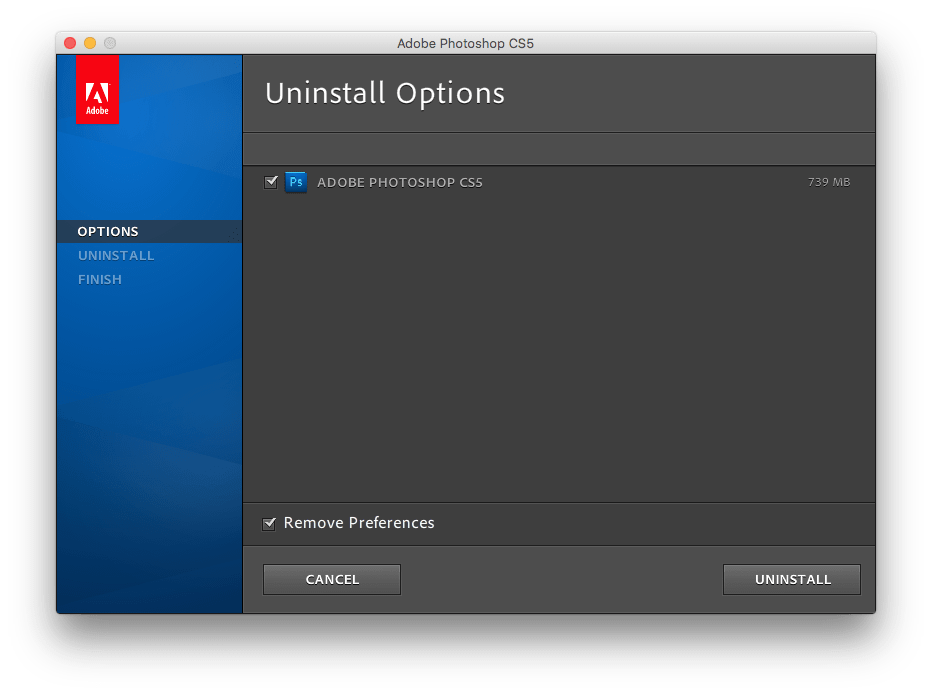In order to remove the Apps in Mac, you only have to open the application folder and drag the app to the Bin or Trash Can. This is rather easy if the program is uninstalled simply. However, if the application still denies to uninstall and stays on the Mac then we need to get another solution below. On Mac, go to Applications Utilities Adobe Installers. Run uninstallers of all the Creative Cloud apps. For example, to uninstall Photoshop CC, double click Uninstall Adobe Photoshop CC. Then double click Uninstall Adobe Creative Cloud to get it uninstalled. Restart your Mac to see if Adobe Creative Cloud is gone.
- How To Uninstall App On Mac Pro
- Cannot Uninstall App On Mac
- How To Uninstall App On Macbook
- How To Uninstall App On Mac
You might install some apps on your Mac, but later find that they are not for you. And you want to delete those applications from your computer to save space for other items.
Actually, uninstalling applications on macOS is easier than that on Windows operating system. Here are some tips on how to uninstall or remove apps from macOS 10. 15 Catalina, macOS 10.14 Mojave and more.

Delete Apps on Mac
The easiest way to uninstall an app from Mac is selecting the application's icon and move it to Trash.
1Click Finder app on the Mac dock.
2 Click the Application folder in the left side panel.
3Go through all the programs until you find the icon of the program that you want to uninstall. Right-click the icon and select Move to Trash or drag the icon right to the trash can.
Note: You can also search the app by entering the name in the search box in the upper right corner. If the program has its own uninstaller application, run the uninstaller program to remove your app.
4 Finally, right-click the trash can icon and select Empty Trash.
Note: If you run Mac as a guest, you may be asked to enter an account and password when you are removing an app. Enter an admin name and password to continue your deletion.
Why Can You Uninstall Programs on Mac by Trash?
Unlike Windows, on a Mac, applications and a user's working space are separated. Typically, programs on Mac are stored in the Application folder while users' preference files are kept in the Library folder. All files about the app are packaged together inside the Application folder, which means everything relating to the app is stored in one place.

If you find your app in the Application folder, right-click the app and select shows package contents, you'll see various files. So, when you delete it, you can delete everything relating to the app.
Uninstall Applications from Launchpad
Another alternative is to use Launchpad, which offers a convenient way to uninstall applications downloaded from App Store.
1Click Launchpad, represented by a spaceship in your Mac Dock. (or click on F4)
2Scroll through the list of your installed apps, then locate the application you want to delete.
3Click and hold the app until a cross appears on the icon. (or press the Option/Alt key)
4Click the cross button in the upper left of the app icon.
To exit deletion mode, simply click anywhere on the screen that's no occupied by an app icon.
/article-new/2019/05/cleanmymac-x-uninstaller-screen.jpg?lossy)
Completely Uninstall Apps on Mac
Sometimes, the methods mentioned above may not completely delete all the files relating to the apps, such as some of your preference files. And you need to remove these files from the Library folder. Here will introduce how to do that.
1Go to the Library folder: open Finder and click Go in the top bar, when the menu shows, click the Option/Alt key.
Note: Usually, you'll not see the Library folder in the Go menu, but it's there. It is hidden because Apple doesn't want you to delete something important.
2The Library option will appear and click the option to open the folder.
3 Go through the lists of this folder to find out the files relating to the application you are uninstalling.
4 Next, open the Application Support directories under Finder to search for data relating to the app you are removing.
Use App Uninstaller for Mac
As mentioned in the last section, the above methods are not enough. There are some tricky apps, which store associated files in the Library folder and it is not convenient to completely uninstall the app by deleting these files one by one.
Luckily, there exist some professional uninstaller apps that can help you delete those tricky apps. FonePaw MacMaster is one of the best app cleaners for Mac. It can remove your unwanted apps without leftovers only in 3 steps, which is cleaner than dragging the app into Trash.
If you want to easily, quickly and permanently uninstall an app from macOS Mojave, Catalina, etc., MacMaster can be helpful.So, how to uninstall an app from Mac in a fast and clean way with MacMaster? The following steps will show you how to do that.
Step 1Launch MacMaster and move to the Uninstaller option.
Step 2Scan the apps on your Mac and select the unneeded application.
Step 3Delete the application and associated files from your Mac by clicking the Clean button.
It is pretty easy, isn't it? Give it a try to make your Mac get back to the new status.
Free Download
Depending on the application and the installation method, you may be able to completely uninstall apps from macOS by simply dragging the .app bundle into the trash. However, that typically leaves behind at least a few preference files. In some cases it can leave behind gigabytes of data.
1: Uninstallers
If possible, you should always default to using the applications uninstaller, if it has one. Applications with web service components, like Adobe Creative Cloud and Microsoft Office 365, should be removed according to the instructions on the developer’s website.
If you’re unsure what kind of uninstall procedure your application requires, you can search the name of the application followed by “uninstall.” This will typically provide a page by the developer describing the uninstall procedure.
If you can’t find anything like that, then the uninstall process is likely trival. Dragging the icon to the trash likely removed the majority of the files, but you can dig further to try and delete even more.
2: Move to Trash
On macOS, applications generally like to stay inside their .app bundle. Compare this to Windows, where an installer can spew files across the system in dozens of arbitrary locations. Although, this happens with some Mac apps as well, as you’ll see if you try to manually uninstall more complex applications.
If an app is simple and self-contained, you can delete its most essential components by simply dragging the application’s icon to the trash. While this will delete everything within the app bundle, it won’t delete any preference files for the applciation, nor can it affect any files created by the application for its own use but stored outside of the app bundle. A program like an email client, for example, might store gigabytes of email data outside of the app bundle. Simply deleting the app bundle from the Application’s directory wouldn’t do anything to affect that.
The good news is that applications purchased from the Mac App Store can be deleted this way most reliably. You can also delete Mac App Store app in the Launchpad view, where you can click and hold to reveal “x” icons on uninstallable apps from the Mac App Store.
Of course, dragging to trash won’t be enough for major applications, which tend to leave files throughout your operating system.
3: App Cleaner
The easiest way to completely uninstall a game on the Mac is with App Cleaner. It works by searching for files associated with the app bundle and deleting everything together at the same time. You can download and install App Cleaner for free, but it costs $10 to unlock the core file-deletion functionality. With the free version of App Cleaner, you can search for apps but not uninstall them.
1. Open App Cleaner.
2. Type the name of the app you want to delete in the search bar at the bottom of the app list.
3.Select the application features you want to remove.
4. Click “Remove” to wipe all selected files from your drive.
How To Uninstall App On Mac Pro
By following the connections in application data and preference lists, App Cleaner is able to reliably dig up obscure, difficult-to-spot connections upon uninstallation.
4: Manual Removal
App Cleaner is useful because not all applications are entirely contained within their app bundles. While some apps can be deleted simply by deleting the .app bundle, not all apps are so well-organized or simplistic. Where are all the files stored? That’s exactly the question you have to answer when it comes to manual removal. If you want to dig up all the files associated with the target application on your own, you’ll need patience and a sharp eye.
Possible Library Folder Locations
To completely uninstall an app from macOS manually, you’ll need to look for files associated with the application in the following folders. Within each folder, look for the name of the application and the name of the company that created it. For example, if you were trying to uninstall Word manually, you would look for both Word and Microsoft.
- /Library
- /Library/Application Support
- /Library/Preferences
- /Library/LaunchAgents
- /Library/LaunchDaemons
- /Library/PreferencePanes
- /Library/StartupItems
- ~/Library/
- ~/Library/Application Support
- ~/Library/LaunchAgents
- ~/Library/Preferences
- ~/Library/PreferencePanes
- ~/Library/StartupItems
Additional Locations
Cannot Uninstall App On Mac
You’ll also need to look for any related kernel extensions. Known as “kexts,” kernel extensions are the drivers of the macOS world. A kext extends the communication ability of the kernel, adding new methods of interfacing with the system. You’ll find them installed in “/System/Library/Extensions,” and you’ll need to search thoroughly for anything related to your application. When you’re ready to remove the kexts, you’ll need to use sudo rm.
You may also find files in the “~/Documents/” folder. This is especially true of applications and games that are ported from Windows to macOS. Storing user files in the Documents folder is a standard, and perhaps annoying, behavior on Windows, and that’s easily transferred to macOS.
Other more complex applications can deposit files in less typical locations. If you install a different shell, for example, you’ll find hidden files and folders associated with that shell in your home directory. With Finder foremost, press Command + Shift + . to reveal hidden folders. Delete any associated files or folders from your home directory.
How To Uninstall App On Macbook
Conclusion
In most cases simply deleting the app bundle is enough to uninstall an app from your Mac. Complete removal is best when the app has large helper files, or you’re attempting to fix some sort of problem by reinstalling the application.
How To Uninstall App On Mac
You might also like the following posts: